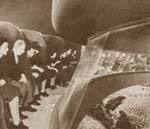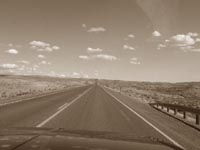 |
|
futurama, autogeddon |
|
Imagining the Superhighway from Bel Geddes to Ballard |
nine : talking to the ghosts of tomorrow
[26] Bel Geddes could not imagine the explosion of private car ownership in his future "autopia"; similarly, estimates that the Interstate highway system would be completed by 1970 were, at best, optimistic: not only is it still not complete in the form it was originally planned, but it must be constantly upgraded to deal with weather damage, earthquake damage, and general wear-and-tear. The Interstate, then, is not a perfect network overlaid on America, but a constantly renegotiated layering of dynamic variables -- traffic patterns, construction, weather. The magic date at which "the future" would be realized -- 1960 -- in effect never happened. construction, weather. [27] But at the same time, the American highways systems are haunted
by Bel Geddes' idealized aesthetics. The grand, curving sweep
of the highways and overpasses, the perfect symmetry of cloverleaf
interchanges, and the deco-inspired architecture of arterial city
highways bear the stamp of Walter Teague and Bel Geddes, fellow
designers for Ford and General Motors in the World's Fair pavilions
of the thirties and forties. Bel Geddes' book Magic Motorways
(1940) would be influential in the process of Interstate highway
design in the 1940s and 1950s, when the complex engineering project
was planned and designed. Bel Geddes' voice, thus, speaks to us
every time we head out, onto the open road. |
| 1 |
| 2 |
| 3 |
| 4 |
| 5 |
| 6 |
| 7 |
| 8 |
| 9 << |
| 10 |
| credits |
| rhizomes |
 [25] And yet, like all idealized networks, the Interstate does not
correspond to itself. This system contains both attempts to homogenize
the driving experience -- gas stations, fast food joints, green
signage -- and unexpected differences -- different colored stone
used in construction, orange cones, inconsistent numbering schemes
for exits. Blown-out tires litter the shoulder of main-line trucking
routes; carcasses of deer and other smaller animals are a grim
reminder of another kind of "road toll" from the one
we are accustomed to hearing. Sections of the Interstate decay;
the clicking, changing sound of the Interstate rolling under wheel
tells us of the cycles of construction and repair that are required
to maintain it in working order. The typical long-distance road
trip today is tempered with three key considerations: the weather,
traffic congestion, and the presence or absence of construction.
[25] And yet, like all idealized networks, the Interstate does not
correspond to itself. This system contains both attempts to homogenize
the driving experience -- gas stations, fast food joints, green
signage -- and unexpected differences -- different colored stone
used in construction, orange cones, inconsistent numbering schemes
for exits. Blown-out tires litter the shoulder of main-line trucking
routes; carcasses of deer and other smaller animals are a grim
reminder of another kind of "road toll" from the one
we are accustomed to hearing. Sections of the Interstate decay;
the clicking, changing sound of the Interstate rolling under wheel
tells us of the cycles of construction and repair that are required
to maintain it in working order. The typical long-distance road
trip today is tempered with three key considerations: the weather,
traffic congestion, and the presence or absence of construction.